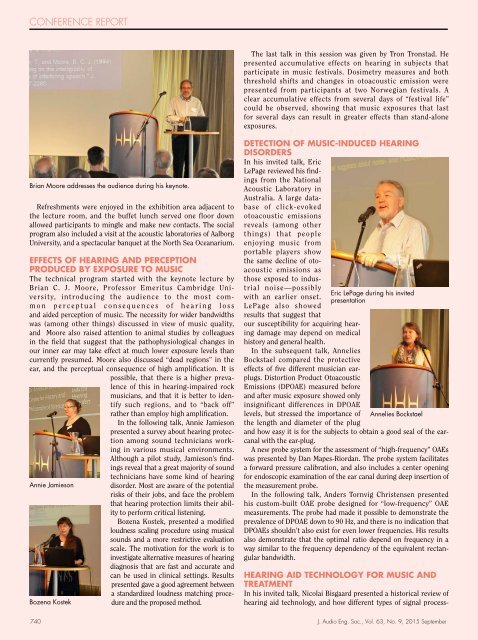Music-Induced Hearing Disorders
58thConference
58thConference
- No tags were found...
You also want an ePaper? Increase the reach of your titles
YUMPU automatically turns print PDFs into web optimized ePapers that Google loves.
CONFERENCE REPORT<br />
The last talk in this session was given by Tron Tronstad. He<br />
presented accumulative effects on hearing in subjects that<br />
participate in music festivals. Dosimetry measures and both<br />
threshold shifts and changes in otoacoustic emission were<br />
presented from participants at two Norwegian festivals. A<br />
clear accumulative effects from several days of “festival life”<br />
could be observed, showing that music exposures that last<br />
for several days can result in greater effects than stand-alone<br />
exposures.<br />
Brian Moore addresses the audience during his keynote.<br />
Refreshments were enjoyed in the exhibition area adjacent to<br />
the lecture room, and the buffet lunch served one floor down<br />
allowed participants to mingle and make new contacts. The social<br />
program also included a visit at the acoustic laboratories of Aalborg<br />
University, and a spectacular banquet at the North Sea Oceanarium.<br />
EFFECTS OF HEARING AND PERCEPTION<br />
PRODUCED BY EXPOSURE TO MUSIC<br />
The technical program started with the keynote lecture by<br />
Brian C. J. Moore, Professor Emeritus Cambridge University,<br />
introducing the audience to the most common<br />
perceptual consequences of hearing loss<br />
and aided perception of music. The necessity for wider bandwidths<br />
was (among other things) discussed in view of music quality,<br />
and Moore also raised attention to animal studies by colleagues<br />
in the field that suggest that the pathophysiological changes in<br />
our inner ear may take effect at much lower exposure levels than<br />
currently presumed. Moore also discussed “dead regions” in the<br />
ear, and the perceptual consequence of high amplification. It is<br />
possible, that there is a higher prevalence<br />
of this in hearing-impaired rock<br />
musicians, and that it is better to identify<br />
such regions, and to “back off”<br />
rather than employ high amplification.<br />
In the following talk, Annie Jamieson<br />
presented a survey about hearing protection<br />
among sound technicians working<br />
in various musical environments.<br />
Although a pilot study, Jamieson’s findings<br />
reveal that a great majority of sound<br />
technicians have some kind of hearing<br />
Annie Jamieson disorder. Most are aware of the potential<br />
risks of their jobs, and face the problem<br />
that hearing protection limits their ability<br />
to perform critical listening.<br />
Bozena Kostek, presented a modified<br />
loudness scaling procedure using musical<br />
sounds and a more restrictive evaluation<br />
scale. The motivation for the work is to<br />
investigate alternative measures of hearing<br />
diagnosis that are fast and accurate and<br />
can be used in clinical settings. Results<br />
presented gave a good agreement between<br />
a standardized loudness matching procedure<br />
and the proposed Bozena Kostek<br />
method.<br />
DETECTION OF MUSIC-INDUCED HEARING<br />
DISORDERS<br />
In his invited talk, Eric<br />
LePage reviewed his findings<br />
from the National<br />
Acoustic Laboratory in<br />
Australia. A large database<br />
of click-evoked<br />
otoacoustic emissions<br />
reveals (among other<br />
things) that people<br />
enjoying music from<br />
portable players show<br />
the same decline of otoacoustic<br />
emissions as<br />
those exposed to industrial<br />
noise—possibly<br />
with an earlier onset.<br />
LePage also showed<br />
results that suggest that<br />
our susceptibility for acquiring hearing<br />
damage may depend on medical<br />
history and general health.<br />
In the subsequent talk, Annelies<br />
Bockstael compared the protective<br />
effects of five different musician earplugs.<br />
Distortion Product Otoacoustic<br />
Emissions (DPOAE) measured before<br />
and after music exposure showed only<br />
insignificant differences in DPOAE<br />
levels, but stressed the importance of<br />
the length and diameter of the plug<br />
Eric LePage during his invited<br />
presentation<br />
Annelies Bockstael<br />
and how easy it is for the subjects to obtain a good seal of the earcanal<br />
with the ear-plug.<br />
A new probe system for the assessment of “high-frequency” OAEs<br />
was presented by Dan Mapes-Riordan. The probe system facilitates<br />
a forward pressure calibration, and also includes a center opening<br />
for endoscopic examination of the ear canal during deep insertion of<br />
the measurement probe.<br />
In the following talk, Anders Tornvig Christensen presented<br />
his custom-built OAE probe designed for “low-frequency” OAE<br />
measurements. The probe had made it possible to demonstrate the<br />
prevalence of DPOAE down to 90 Hz, and there is no indication that<br />
DPOAEs shouldn’t also exist for even lower frequencies. His results<br />
also demonstrate that the optimal ratio depend on frequency in a<br />
way similar to the frequency dependency of the equivalent rectangular<br />
bandwidth.<br />
HEARING AID TECHNOLOGY FOR MUSIC AND<br />
TREATMENT<br />
In his invited talk, Nicolai Bisgaard presented a historical review of<br />
hearing aid technology, and how different types of signal process-<br />
740 J. Audio Eng. Soc., Vol. 63, No. 9, 2015 September


